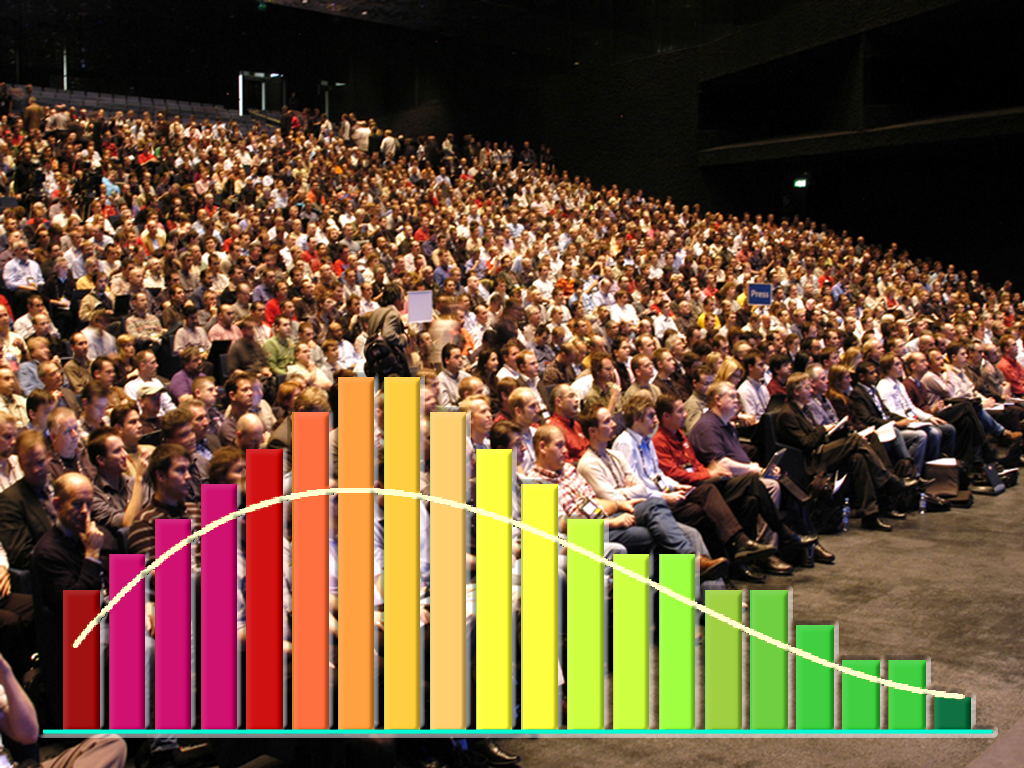Our largest obstacle and worst financial enemy is usually easy to find: it’s us. If you put a thousand randomly picked stock traders into a room and allowed each of them to trade with a fixed amount of money, for a fixed amount of time, you would expect their performance to approximately fit a bell shaped curve. The harsh reality is that the result would be dramatically worse than what a probability curve would predict. There are several reasons for this. First, many traders do not consider any kind of risk management. Secondly their trades are often picked, sized, bought and sold with an emotional bias, rather than a fundamental or technical basis. To put this another way, they did not have a trading plan. Conformational bias destroys the value of many trading accounts. This lack of a detailed and rational trading plans sabotages less skilled traders at some point in their trading endeavors, even if they had great trading success initially.
Some primal instinct in us makes us still believe that the bigger the kill – the bigger the thrill, and by extension the more we have accomplished toward our family’s provisioning, thus guaranteeing their and our survival. When we encounter these situations a powerful surge of dopamine is produced in our brains. Since money is the provisioning element in modern society, obtaining it through risk produces the same dopamine response as if you were attempting to stalk and bring down big game. At least in trading stocks, where education, restraint, patience, superior information and discipline win out, the thrill is wrong!
So the results of the experiment described above would be substantially worse than what probability would predict. Specifically there would be more negative accounts, more neutral accounts and fewer positive accounts than a bell shaped curve would predict.
The greatest enemy of all traders is our emotions. Greed and fear fuel the markets and traders actions. Many inexperienced traders greedily purchase stocks when they see them running up over several days or weeks. Purchasing the stock somewhere around the large green dot in the graphic at the top of this page. Unfortunately this roller coaster ride is not over and they see their stock move over the tipping point and start to go down. Often they don’t sell stocks (or have stops in place) that are dropping and incur large losses hopping without any foundation that by not selling, they will recoup their loses when the stock rebounds? Finally, when the stock declines to a point where their fear overcomes logic, producing panic, they sell all of their holdings around the large red dot, fearing that they will lose all of their money. As Warren Buffett would gladly tell you, these people have the process exactly backwards. To quote him, “you want to be greedy when other are fearful and fearful when others are greedy”.
Nothing will remove you from this fate faster than learning technical analysis and the basic premise of support and resistance. SDG utilizes these two levels as the primary demarcations for entering and exiting all trades, no matter what time frame you may favor. Once you have become accosted to utilizing these entry and exit cues, the roller coaster ride above will become a funny joke to you, instead of the nightmare that it represents to so many.
Traders who have experienced a period of high profits are exuberant and confident about the future, scientist have also demonstrated that their testosterone levels are elevated. Traders, who have experienced a series of losses, can and often do experience depression.
Many traders fail to generate profits because of a fear of executing new trades. If you are trading from a pre-screend list of good quality stocks, are entering money/risk managed purchases and have entered a Stop Loss order for every trade, you will have eliminated many of the elements causing this fear (because the risk is greatly reduced) and you will start trading fearlessly. This enables you to follow your trading plan without hesitation.
Sometimes your attitude can filter information in a manor that will cause you to not make the best decision. This is called conformational bias. I recientely read a excellent novel, “Ireland,” by Frank Delaney about an Irish storyteller. In the authors notes he inadvertenely provided a great description of conformational bias. “We merge our myths with our facts according to our feelings. We tell ourselves our own story, and no matter what we are told, we choose what we believe. All truthes are only our truths, because we bring to facts, our feelings, our experiences, our wishes.”[1]
Conformational bias can be very hard to detect in yourself until you see a stock you own drop in price, and to you, it was completely unexpected. After all, you read a great deal about the company and it was all positive! If you have a predisposed opinion of what the outcome of purchasing a stock will be, it is very possible that when you read something positive reguarding this company your opinion will be reinforced. When you read something negative about the same company, because of you predisposed opinion, you discount this negative information.
Physiologically this is a very difficult emotional barrier to overcome, because most of the time we do not realize that we are doing it, until a stock we had strong convictions about, dumps on us and we go back and find out exactly why it suddenly declined was very evident in the negative information that we had previously ignored.
Ironically, learning how to short stocks will assist you in overcoming this human trait and SDG provides a agnostic platform that is equally adept at going long or going short. If you start to examine stocks from the perspective of; I can make money in this equity if it’s going up or down, and examine the information from this neutral starting point, you can then more accurately digest both the positive and the negative information you encounter. When I am reading any article about any equity I own or that I am considering purchasing, I now force myself to give equal weight to both the negative and the positive information that I encounter, all the while balancing the final judgement, not to confirm a preconceived notion, but to decide which side of the trade I want to enter. Not doing this has been painful and expensive.
Why We Think We’re Better Investors Than We Are
The link above is to an excellent and recent New York Time's article on some of the emotional land-mines that each traders need to learn to recognize and avoid.
One final note on emotional trades based on rumors. Unless you know and trust the original source and you are getting it from that source, you are entering uncharted and dangerous waters.
[1] Ireland a Novel by Frank Delaney, Harper Collins, Oct 9th 2009


















